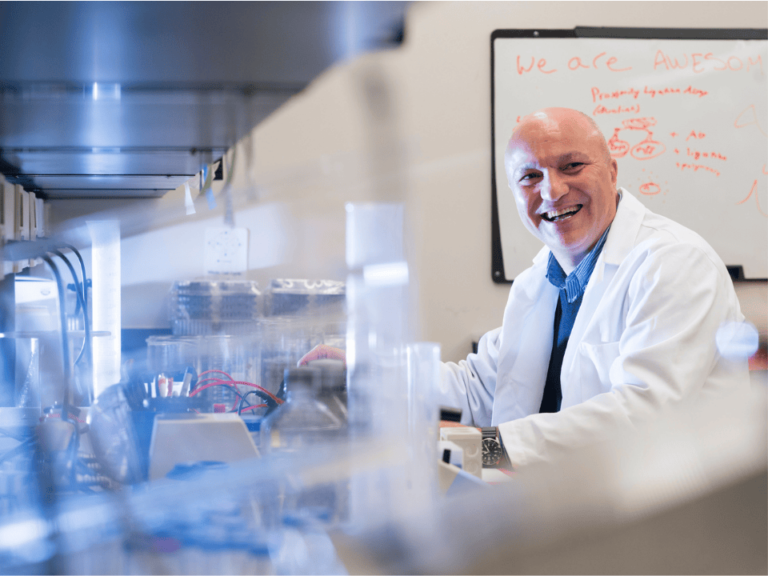Basic research should have at least 20% of the budget at the Frederick Cancer Research Center and should be directed by a person “of outstanding caliber and stature … whose personality, philosophy, and attitudes will set the tone of the whole program and whose inspiration and leadership will create an esprit de corps that is essential to success.”
That is the conclusion of the ad hoc advisory committee on the Frederick Center in its final report to the National Cancer Advisory Board. The committee was headed by Sidney Weinhouse, director of Fell Research Institute.
The committee reviewed the program and facilities at the former biological warfare center in Ft. Detrick, Md., where Litton-Bionetics, Inc. operates the facility for NCI on a $10-million contract. The committee found that research programs there now are targeted toward specific objectives of the National Cancer Program “in a reasonably satisfactory manner.”
If that is to be the only purpose of the center, the report says it needs only some organizational improvements to clarify the lines of authority, responsibility, and communication. “The center would then have a worthwhile, well-defined but limited role as a provider of products and services, both to NCI and to the outside scientific community.”
That wasn’t what President Nixon or the NCAB had in mind in the sword-to-ploughshare conversion of Ft. Detrick. It was to become an international center of leadership in the cancer program. The Weinhouse committee found that the present structure does not provide the kind of effective scientific leadership such a goal requires.
The present Litton staff is competent for the scientific management of the present program, the report says. “But neither the general manager Robert Stevenson nor the director of science John Landon, fulfill the requirements of a director whose judgment, foresight, and reputation will make it possible to recruit the top-flight scientists” needed to give the center the role envisioned for it.
The director of the basic science program would be “a leader of a team of innovative scientists, each of whom has the freedom to pursue his own project without specific direction from above,” the report says.
The director should have a high-level status within the NCI administration, the report notes. In a preliminary report to NCAB last June, Weinhouse had suggested that the director would be the equivalent of a division director. That drew fire from existing big division directors who have their own programs at the center. The final report suggests that the entire operation of the center be under the Division of Cancer Cause & Prevention, which already funds about 80% of the center’s total budget.
The present budget for service-oriented research is about $9.5 million. Twenty per cent ($2.5 million) should support 10-20 independent investigators and their staffs, the report says. “This would establish a reasonable balance with the targeted research.”
The center should be free to develop appropriate academic affiliations, the report suggests. It is within an hour’s drive of Johns Hopkins, Univ. of Maryland, George Washington Univ., and the Hershey Medical Center. Affiliation need not be with a single institution.
The committee objected to the fact that NCI awards the contract to Litton on a year-to-year basis, fearing that the lack of security and continuity could impair the search for a top-flight scientist to run the program. Carl Frett pointed out that a provision exists in the Litton contract permitting its Frederick staff to switch to the successful contractor if Litton loses the job.
NCI Director Frank Rauscher asked what the director’s special field of interest should be. “A microbiologist? An expert in chemical carcinogenesis? Perhaps we should determine that before we start looking for someone? Does the country need another lab for viral oncology more than one in chemical carcinogenesis?”
“Those are the wrong questions to ask,” said Sol Spiegelman, Columbia, an NCAB member. “Get the best guy you can.”
The report said the committee considered the fact that “this unique facility was made available to the National Cancer Program with high hopes and expectations that it would become an internationally renowned institution, at the forefront of the cancer effort, providing both research and service functions of the highest quality.”
The Center now has programs in three major project areas—chemical carcinogenesis, viral oncology, and animal production and holding. Chemical carcinogenesis projects are:
- Bioassay and studies on bowel cancer investigating metabolism of selected bacterial species.
- Large-scale bioassay, involving selected compounds and effects on mice and rats.
- Preparation and characterization of carcinogens.
- Bioassay methodology for potential carcinogens.
Viral oncology projects include:
- Virus production: 150 liters per week of oncogenic or suspected oncogenic viruses.
- Development research: Development of protocols for virus production.
- Preparation of viral diagnosis and test reagents from selected viruses.
- Viral oncology research: Basic research in direct support of existing programs in the viral etiology of human neoplasia.











